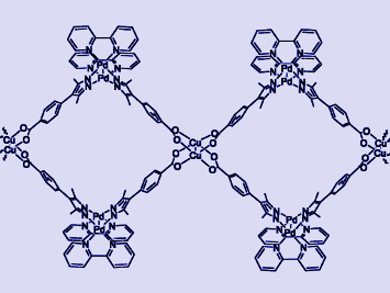Heterometal–organic supramolecular architectures which consist of two or more kinds of metal ions with organic ligands have attracted considerable research interest in modern coordination chemistry. This is due to their wide range of possible applications, e.g., in supramolecular magnetism, catalysis, or sensing.
Shu-Yan Yu, Jin Tong, Beijing University of Technology, China, and colleagues have developed a strategy for a programmable self-assembly method that allows the synthesis of heterometal–organic supramolecules by using bifunctional ligands HnAB (n = 1, 2; A, B = functional groups of the organic ligand) with a proton switch function that can control the coordination order of the different metals. The metals self-sort based on the fact that different metals have different affinities for a particular donor atom.
Using this approach, the team synthesized a heterometallic palladium(II)–copper(II) 1D grid-chain (structure pictured), composed of [Cu2(O2CPh)4]n bridges and dinuclear [(bpy)2Pd2L2] corners (bpy = 2,2-bipyridine). For this, they used the bifunctional ligand 4-(3,5-dimethyl-1H-pyrazol-4-yl) benzoic acid (H2L). The heterometallic Pd(II)–Cu(II) complexes have an enhanced catalytic activity for Suzuki cross-coupling reactions compared with homodimetallic complexes.
- Programmable self-assembly of heterometallic palladium(II)-copper(II) 1-D grid-chain using dinuclear palladium(II) corners with pyrazole-carboxylic acid ligands,
Wen-Qing Sun, Jin Tong, Hong-Lin Lu, Ting-Ting Ma, Shu-Yan Yu, Hong-Wei Ma,
Chem. Asian J. 2018.
https://doi.org/10.1002/asia.201701766




